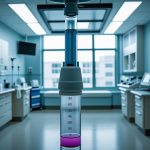Maintaining proper hydration is foundational to overall well-being, impacting everything from cognitive function and energy levels to physical performance and even mood. However, achieving optimal hydration isn’t simply about drinking more water; it’s about finding the right balance for your individual needs. Many people unknowingly fall into patterns of overcorrection – drastically increasing fluid intake after realizing they are dehydrated, then potentially leading to hyponatremia (low sodium levels) or simply feeling uncomfortable and bloated. This cycle stems from a misunderstanding of how our bodies regulate fluids and a reliance on reactive rather than proactive hydration strategies. The goal isn’t just to quench thirst when it arises; it’s about consistently supporting the body’s natural fluid balance throughout the day, preventing significant dehydration in the first place.
The challenge lies in the fact that thirst isn’t always a reliable indicator of hydration status. By the time you feel thirsty, you are already mildly dehydrated. Furthermore, factors like activity level, climate, diet, and individual metabolic rate all significantly influence fluid needs. Traditional advice often focuses on arbitrary daily water intake recommendations (like eight glasses), which don’t account for these personal variations. This is where hydration tools come into play – not as replacements for listening to your body, but as aids in understanding its signals and tailoring your approach to fluid consumption. These aren’t necessarily high-tech gadgets; they can range from simple tracking apps to smart water bottles with personalized reminders, all designed to promote consistent, balanced hydration and prevent the pitfalls of reactive overcorrection.
Smart Hydration Tracking & Personalized Reminders
The first step in preventing flow overcorrection is gaining awareness of your individual hydration patterns. Smart hydration trackers – often integrated into fitness wearables or available as standalone apps – help you do just that. These tools typically work by allowing you to log your fluid intake throughout the day, and some even factor in activity levels, weather conditions, and personal characteristics (like weight) to estimate your daily fluid needs. The key difference from simply trying to drink more water is the focus on consistency and personalization. Instead of a sudden surge in intake after realizing you’re thirsty, you’re encouraged to sip fluids regularly throughout the day, based on your individual requirements.
Many apps go beyond simple logging by offering personalized reminders – gentle nudges to take a sip of water at regular intervals. This is particularly helpful for people who are busy or tend to forget to drink. Crucially, these reminders aren’t about forcing down large volumes of liquid; they’re about encouraging small, consistent sips that maintain fluid balance. Sophisticated trackers can even learn your habits over time and adjust reminder frequency accordingly. Some advanced systems integrate with smart water bottles (discussed below) for automated tracking and data synchronization, providing a more seamless experience. The benefit isn’t just preventing dehydration; it’s establishing a habit of consistent hydration that becomes second nature. Understanding how to prevent common hydration mistakes is also crucial for long-term health.
The real power of these tools is in the data they provide. By analyzing your intake patterns over time, you can identify trends and adjust your strategy accordingly. Are you consistently underhydrated during certain activities? Do you tend to forget to drink on busy workdays? This information allows for a more tailored approach, moving away from generalized recommendations towards a hydration plan that is truly suited to your lifestyle.
Electrolyte Monitoring & Balanced Intake
Hydration isn’t just about water; it’s also about electrolytes – minerals like sodium, potassium, magnesium, and chloride that play vital roles in maintaining fluid balance and nerve function. When you sweat, you lose electrolytes, and simply replenishing with water can dilute your electrolyte levels, potentially leading to hyponatremia. This is a common cause of overcorrection; people drink excessive amounts of water without replacing lost electrolytes.
Several new tools are emerging that address this challenge by offering electrolyte monitoring capabilities. These range from wearable sensors that measure sweat composition during exercise to at-home testing kits that analyze urine or blood samples for electrolyte levels. Understanding your individual electrolyte loss is crucial, especially if you engage in strenuous activity or live in a hot climate. Based on the results of these tests, you can adjust your fluid intake and incorporate electrolyte-rich beverages or supplements into your hydration plan. Maintaining proper balance also involves considering nutritional rhythms that support overall health.
Properly balanced hydration involves not only drinking enough water but also ensuring adequate electrolyte replenishment. This isn’t about chugging sports drinks after every workout; it’s about understanding your needs and making informed choices to maintain a healthy balance. Consider these points:
– Focus on whole food sources of electrolytes like bananas (potassium), leafy greens (magnesium), and salty snacks in moderation (sodium).
– If you are engaging in prolonged or intense exercise, consider electrolyte replacement drinks designed for athletes.
– Avoid overdoing it with sugary sports drinks, as these can negate the benefits of hydration.
Smart Water Bottles & Automated Tracking
Smart water bottles represent a significant advancement in hydration technology. These aren’t just aesthetically pleasing containers; they are equipped with sensors and connectivity features that help you track your intake and stay on top of your hydration goals. Many smart bottles automatically monitor how much you drink throughout the day, syncing data to a companion app on your smartphone. This eliminates the need for manual logging, making it easier to maintain consistent tracking.
Some advanced models even offer personalized reminders, glowing or vibrating when it’s time to take a sip, and can adjust hydration goals based on activity level or environmental factors. The automated tracking feature is particularly useful for preventing overcorrection because it provides real-time feedback on your fluid intake. You can see exactly how much you’ve consumed throughout the day, allowing you to avoid unnecessary increases in water consumption. It’s also helpful to incorporate daily routines that support healthy habits.
The convenience factor is also significant. Having a smart water bottle serves as a constant visual reminder to stay hydrated, encouraging consistent sipping throughout the day. This proactive approach is far more effective than relying on thirst cues or sporadic bursts of drinking. Ultimately, these bottles shift hydration from a reactive task to an integrated part of your daily routine.
Hydration Apps & Gamification
Beyond tracking and reminders, many hydration apps are incorporating gamification elements to make staying hydrated more engaging and fun. These apps often reward users for meeting their hydration goals with virtual badges, points, or even challenges against friends. This taps into our intrinsic motivation to achieve and compete, making the process of drinking water feel less like a chore and more like a rewarding activity.
Gamification can be particularly effective for people who struggle with consistency or find it difficult to motivate themselves to drink enough water. The app provides a sense of accountability and encourages regular sipping throughout the day. Some apps even allow you to create personalized hydration challenges, setting specific goals and tracking your progress over time. This fosters a sense of ownership and commitment, making it more likely that you’ll stick with your hydration plan. Consider how hydration cycles can contribute to restful sleep.
Furthermore, many hydration apps offer educational resources, providing information about the benefits of proper hydration and offering tips for staying hydrated in different situations. This empowers users to make informed choices about their fluid intake and understand how their bodies respond to changes in hydration levels. The best apps combine tracking, reminders, gamification, and education to create a comprehensive hydration solution that is both effective and enjoyable. They move the focus from simply drinking more water to building a sustainable and balanced hydration habit.
The key takeaway is this: hydration tools aren’t about rigid adherence to arbitrary rules; they’re about empowering you with information and support to find what works best for you. By leveraging technology and understanding your individual needs, you can avoid the pitfalls of flow overcorrection and achieve optimal hydration – a cornerstone of health and well-being. To further enhance your overall wellness, explore mindful hydration techniques.





















